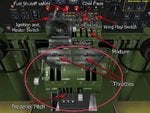technique72
Airman
- 11
- Aug 3, 2018
Hi everyone
I am new on here.
I am doing some research on the history of the gear and flap controls.
More specifically the incidents of crashes due to pilot confusing the gear and flap controls during landing in B17s.
In 1942, Alphonso Chapanis interviewed pilots who had survived the crashes in these B-17. After weeks of interviews he returned to the cockpit of the plane. He discovered that due to the proximity and similar shape of the landing gear and wing flap levers, a tired pilot thinking he was controlling the wing flaps to control speed, would accidentally retract the plane's wheels on landing, causing obvious catastrophe.
Due to this research, the Air Force attached wheel-shaped knobs to the landing gear control and wedge-shaped knobs to the wing flap controls so they wouldn't get confused.
I am wondering do any of the experts on this forum know any more on this? Does anyone have photographs of these controls before and after modifications were made to them?
Any help would be great. Thanks
I am new on here.
I am doing some research on the history of the gear and flap controls.
More specifically the incidents of crashes due to pilot confusing the gear and flap controls during landing in B17s.
In 1942, Alphonso Chapanis interviewed pilots who had survived the crashes in these B-17. After weeks of interviews he returned to the cockpit of the plane. He discovered that due to the proximity and similar shape of the landing gear and wing flap levers, a tired pilot thinking he was controlling the wing flaps to control speed, would accidentally retract the plane's wheels on landing, causing obvious catastrophe.
Due to this research, the Air Force attached wheel-shaped knobs to the landing gear control and wedge-shaped knobs to the wing flap controls so they wouldn't get confused.
I am wondering do any of the experts on this forum know any more on this? Does anyone have photographs of these controls before and after modifications were made to them?
Any help would be great. Thanks

